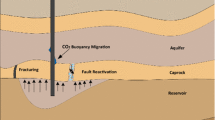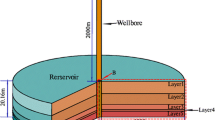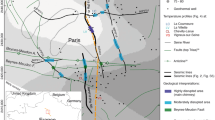Abstract
Carbon capture and storage (CCS) activities at the Snøhvit field, Barents Sea, will involve carrying out an analysis to determine which parameters affect the migration process of CO2 from the gas reservoir, to what degree they do so and how sensitive these parameters are to any changes. This analysis will aim to evaluate the effects of applying a broad but realistic range of reservoir, fault and gas chimney properties on potential CO2 leakage at various depths throughout the subsurface. Fluid flow might take place through parts of or the entire extent of the overburden. One of the aims of the analysis is assessing the potential of CO2 reaching the seabed. Using the Snøhvit gas reservoir and overburden in the Barents Sea, a series of geological models were built using seismic and well-log data. We then performed numerical simulations of CO2 migration in focused fluid flow structures. Identification of potential migration pathways and their extent, such as gas chimneys and faults, and their incorporation into these models and simulations will provide a realistic insight into the migration potential of CO2. In the simulations the CO2 is injected over a 20 year period at a rate of 0.7 Mt/year and migration is allowed to take place over a 2000 year time frame for domains of approximately 21 km2 for the caprock fault models, 24 km2 for the realistic gas chimney models and 35 km2 for the generic gas chimney models, in a layered sedimentary succession. The total mass of CO2 injected in the reservoir during the 20-year injection period is 14 Mt. There is a strong interaction between the various parameters but the parameter that had the most influence on the CO2 migration process was probably the permeability of the reservoirs, especially the average permeability (k). Also, for the faulted caprock scenarios, it should be noted that at near surface depths the permeability of 765 mD is already adequate for a good CO2 flow. At the chimney top level (600 m) however, a further increase in permeability has an additional effect on improving CO2 flow. Overall, considering the slow upward migration velocity of the plume, this geological setup can be regarded as a suitable storage site.







Similar content being viewed by others
References
Arntsen B, Wensaas L, Loseth H, Hermanrud C (2007) Seismic modeling of gas chimneys. Geophysics 72:Sm251–Sm259. doi:10.1190/1.2749570
Bastian P et al (2006) The Distributed and Unified Numerics Environment (DUNE). Grid Interface Proceedings of the 19th Symposium on Simulation Technique in Hannover
Bennett MH, Flemings PB, Hicks JR PJ, Shaw CA, Symington WA (1998) Simulation of secondary migration in faults: dynamic controls on hydrocarbon column height. Aapg Bull 82. doi:10.1306/00AA868E-1730-11D7-8645000102C1865D
Bielinski A (2007) Numerical simulation of CO2 sequestration in geological formations. PhD Thesis, Stuttgart University
Buenz S, Tasianas A, Karstens J, Berndt C, Darcis M, Flemisch B (2012) Sub-seabed CO2 Storage: Impact on marine ecosystems (ECO2), Milestone Report (MS12): geological models for industrial storage sites, University of Tromsø, Norway, GEOMAR Helmholtz Centre for Ocean Research Kiel, Germany and University of Stuttgart, Germany
Cartwright J, Huuse M, Aplin A (2007) Seal bypass systems. Aapg Bull 91:1141–1166. doi:10.1306/04090705181
Cathles LM, Su Z, Chen DF (2010) The physics of gas chimney and pockmark formation, with implications for assessment of seafloor hazards and gas sequestration (vol 27, pg 82. Mar Petrol Geol 27:993–994. doi:10.1016/j.marpetgeo.2010.01.004
Chenevert ME and Sharma AK (1991) Permeability and effective pore pressure of shales. Paper SPE/IADC 21918 presented at the 1991 SPE/IADC Drilling Conference, Amsterdam, 11–14 Mar 1991
Darcis MY (2012) Coupling models of different complexity for the simulation of CO2 storage in deep saline aquifers. PhD thesis, Institut für Wasser- und Umweltsystemmodellierung, Universität Stuttgart
ECO2 (2014) Best practice guidance for environmental risk assessment for offshore CO2 geological storage EU Grant Agreement No 265847. Deliverable 14.1
ECO2 (2015) ECO2 Final publishable summary report. http://www.eco2-projecteu/homehtml. Accessed 30 June 2015
Edlmann K, Haszeldine S, McDermott CI (2013) Experimental investigation into the sealing capability of naturally fractured shale caprocks to supercritical carbon dioxide flow Environ. Earth Sci 70:3393–3409. doi:10.1007/s12665-013-2407-y
Edlmann K, Edwards MA, Qiao XJ, Haszeldine RS, McDermott CI (2015) Appraisal of global CO2 storage opportunities using the geomechanical facies approach Environ. Earth Sci 73:8075–8096. doi:10.1007/s12665-014-3965-3
Eigestad GT, Dahle HK, Hellevang B, Riis F, Johansen WT, Oian E (2009) Geological modeling and simulation of CO2 injection in the Johansen formation. Computat Geosci 13:435–450. doi:10.1007/s10596-009-9153-y
Eiken O, Ringrose P, Hermanrud C, Nazarian B, Torp TA, Hoier L (2011) Lessons learned from 14 years of CCS operations: Sleipner, IN Salah and Snohvit. Energy Proced 4:5541–5548. doi:10.1016/j.egypro.2011.02.541
Faleide JI et al (2008) Structure and evolution of the continental margin off Norway and Barents Sea. Episodes 31:82–91
Flemisch B et al (2011) Dumu x: Dune for multi-(phase, component, scale, physics,…) flow and transport in porous media. Adv Water Resour 34:1102–1112
Gabrielsen RH, Færseth RB, Jensen LN, Kalheim JE, Riis F (1990) Structural elements of the Norwegian Continental Shelf. Part 1: the Barents Sea region. Norw Pet Dir Bull 6:33
Gonzalez-Nicolas A, Cody B, Bau D (2012) Stochastic analysis of factors affecting the leakage of CO2 from injected geological basins. XIX International Conference on Water Resources CMWR 2012, University of Illinois at Urbana-Champaign
Green CP, Ennis-King J (2012) Spatial grid correction for short-term numerical simulation results of carbon dioxide dissolution in saline aquifers. Computat Geosci 16:1153–1161. doi:10.1007/s10596-012-9309-z
Handy MR, Hirth G, Hovius N (2007) Tectonic faults: agents of change on a dynamic Earth. Dahlem Workshop reports, vol 95. MIT Press
Hansen JØ and Rasen B (2012) Facts 2012: The Norwegian petroleum sector. Annual Report, Norwegian ministry of petroleum and energy and Norwegian petroleum directorate, Stavanger, Norway. Mar 2012
Hansen O, Eiken O, Østmo S, Johansen RI, Smith A (2011) Monitoring CO2 injection into a fluvial brine-filled sandstone formation at the Snøhvit field, Barents Sea. SEG San Antonio 2011 annual meeting
Helmig R (1997) Multiphase flow and transport processes in the subsurface: a contribution to the the modeling of hydrosystems. Springer, Berlin
House KZ, Schrag DP, Harvey CF, Lackner KS (2006) Permanent carbon dioxide storage in deep-sea sediments (vol 103, pg 12291. P Natl Acad Sci USA 103:14255
In cooperation with the Freie Universität Berlin, Cambridge, Mass. Berlin
Janssen C, Wirth R, Reinicke A, Rybacki E, Naumann R, Wenk HR, Dresen G (2011) Nanoscale porosity in SAFOD core samples (San Andreas Fault). Earth Planet Sci Lett 301:179–189. doi:10.1016/j.epsl.2010.10.040
Katsube TJ, Mudford BS, Best ME (1991) Petrophysical characteristics of shales from the Scotian Shelf. Geophysics 56:1681–1689. doi:10.1190/1.1442980
Kim GY, Yi BY, Yoo DG, Ryu BJ, Riedel M (2011) Evidence of gas hydrate from downhole logging data in the Ulleung Basin, East Sea. Mar Petrol Geol 28:1979–1985. doi:10.1016/j.marpetgeo.2011.01.011
Kissinger A, Noack V, Knopf S, Scheer D, Konrad W, Class H (2014) Characterization of reservoir conditions of CO2 storage using a dimensionless gravitation number applied to the North German Basin. Sustain Energies Technol Assess. (submitted)
Ligtenberg JH (2005) Detection of fluid migration pathways in seismic data: implications for fault seal analysis. Basin Res 17:141–153. doi:10.1111/j.1365-2117.2005.00258.x
Linjordet A, Olsen RG (1992) The jurassic Snohvit gas-field, hammerfest basin, offshore northern Norway. Aapg Memoir 54:349–370
Loseth H, Gading M, Wensaas L (2009) Hydrocarbon leakage interpreted on seismic data. Mar Petrol Geol 26:1304–1319. doi:10.1016/j.marpetgeo.2008.09.008
Løtveit FI, Gudmundsson A, Sydnes M (2012) How the stress changes due to glacial erosion may have caused leakage of hydrocarbons in the SW Barents Sea Arctic Frontiers Conference Presentation
Makurat A, Torudbakken B, Monsen K, Rawlings C (1992) Cenezoic uplift and caprock Seal in the Barents Sea: fracture modelling and seal risk evaluation. 1992/1/1/
Maldal T, Tappel IM (2004) CO2 underground storage for Snohvit gas field development. Energy 29:1403–1411. doi:10.1016/j.energy.2004.03.074
Meldahl P, Heggland R, Bril B, De Groot P (2001) Identifying faults and gas chimneys using multiattributes and neural networks. Leading Edge 20:474–478
Mizoguchi K, Hirose T, Shimamoto T, Fukuyama E (2008) Internal structure and permeability of the Nojima fault, southwest Japan. J Struct Geol 30:513–524. doi:10.1016/j.jsg.2007.12.002
Moore DE, Lockner DA, Ito H, Ikeda R, Tanaka H, Omura K (2009) Geometry of the Nojima Fault at Nojima-Hirabayashi, Japan—II. Microstructures and their implications for permeability and strength. Pure Appl Geophys 166:1669–1691. doi:10.1007/s00024-009-0513-2
Moumets H and Polivach Y, Zamora CS (2015) National Inventory Report—Snøhvit field 2014
Nordbotten JM, Celia MA (2012) Geological storage of CO2: modeling approaches for large-scale simulation. Wiley, New Jersey
Norden B, Forster A, Behrends K, Krause K, Stecken L, Meyer R (2012) Geological 3-D model of the larger Altensalzwedel area, Germany, for temperature prognosis and reservoir simulation. Environ Earth Sci 67:511–526. doi:10.1007/s12665-012-1709-9
Opara AI (2011) Estimation of multiple sources of overpressures using vertical effective stress approach: case study of the Niger Delta, Nigeria. Petrol Coal 53(4):302–314
Ostanin I, Anka Z, Primio RD, Bernal A (2012) Identification of a large Upper Cretaceous polygonal fault network in the Hammerfest basin: implications on the reactivation of regional faulting and gas leakage dynamics, SW Barents Sea. Mar Geol 332–334:109–125. doi:10.1016/j.margeo.2012.03.005
Ostanin I, Anka Z, di Primio R, Bernal A (2013) Hydrocarbon plumbing systems above the Snohvit gas field: structural control and implications for thermogenic methane leakage in the Hammerfest Basin, SW Barents Sea. Mar Petrol Geol 43:127–146. doi:10.1016/j.marpetgeo.2013.02.012
Ouakad HM, Nasrabadi H (2012) Onset of convection and advection in the CO2 sequestration-problem using the lattice Boltzmann method. Int J Adv Sci Eng Technol 2:68–75
Rodrigues Duran E, di Primio R, Anka Z, Stoddart D, Horsfield B (2013) Petroleum system analysis of the Hammerfest Basin (southwestern Barents Sea): comparison of basin modelling and geochemical data. Organic Geochem 63:105–121. doi:10.1016/j.orggeochem.2013.07.011
Schutze C et al (2012) Natural analogues: a potential approach for developing reliable monitoring methods to understand subsurface CO2 migration processes. Environ Earth Sci 67:411–423. doi:10.1007/s12665-012-1701-4
Van Oort E, Hale AH, Mody FK, Sanjit R (1996) Transport in shales and the design of improved waterbased shale drilling fluids. SPE Dril Compl 11:137–146
Wibberley CAJ, Shipton ZK (2010) Fault zones: a complex issue. J Struct Geol 32:1554–1556. doi:10.1016/j.jsg.2010.10.006
Worsley D, Johansen R, Kristensen SE (1988) The Mesozoic and Cenozoic succession of Tromsøflaket In: Dalland A, Worsley D, Ofstad K (eds) A lithostratigraphic scheme for the Mesozoic and Cenozoic Succession Offshore Mid and Northern Norway. Norwegian Petroleum Directorate Bulletin No. 4, pp 42–65
Acknowledgments
This work was partly supported by the Research Council of Norway through its Centers of Excellence funding scheme, project number 223259. The research leading to these results has received funding from the European Union Seventh Framework Programme (FP7/2007–2013) under Grant Agreement No 265847.
The authors would like to thank the ECO2 project consortium members for their collaboration in leading to the writing of this paper. The authors are Grateful to Statoil for the seismic data set they provided that enabled the construction of the geological models and various researchers for their advice on parameter value selections. The authors also acknowledge the inputs of the various instructors of various model building courses for providing the necessary tools and knowhow for starting the work. Dr. Rainer Helmig is thanked for hosting me at the Department of Hydromechanics and Modeling of Hydrosystems in Stuttgart in order to better cooperate and coordinate this analysis. I would also like to thank Dr. Bernd Flemisch, from the same department, for taking the first steps in bringing the Tromsø and Stuttgart teams together. The authors are also indebted to the technical support from Schlumberger for being always available to provide solutions to technical issues that arose during the model building process.
Author information
Authors and Affiliations
Corresponding author
Rights and permissions
About this article
Cite this article
Tasianas, A., Mahl, L., Darcis, M. et al. Simulating seismic chimney structures as potential vertical migration pathways for CO2 in the Snøhvit area, SW Barents Sea: model challenges and outcomes. Environ Earth Sci 75, 504 (2016). https://doi.org/10.1007/s12665-016-5500-1
Received:
Accepted:
Published:
DOI: https://doi.org/10.1007/s12665-016-5500-1




